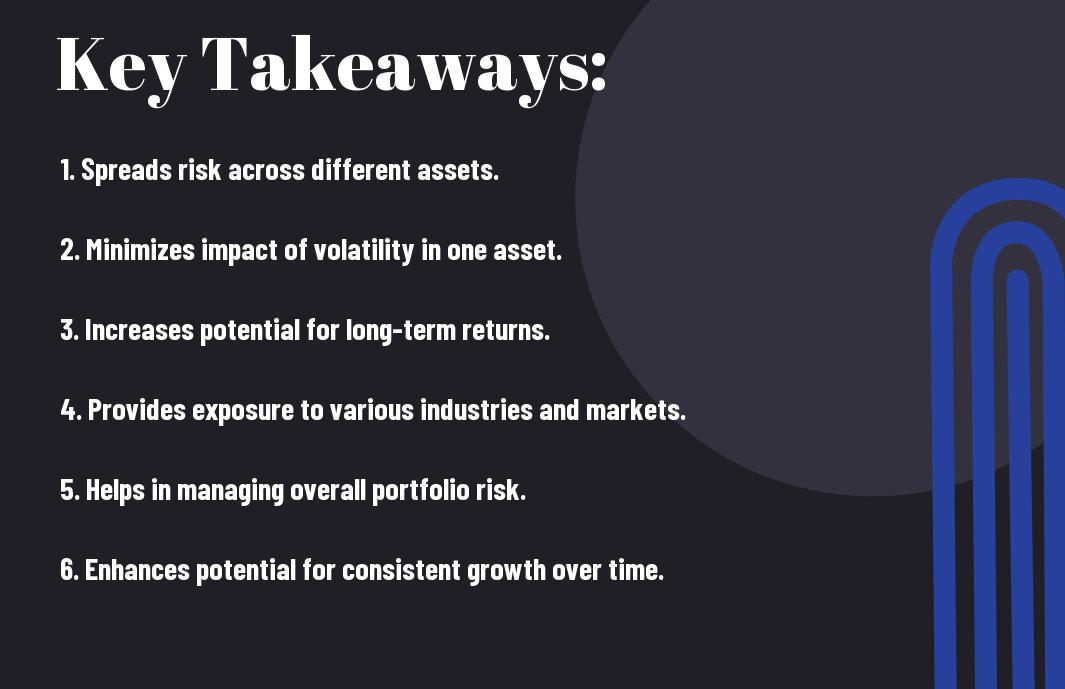With the volatile nature of the financial markets, diversification in your investments is key to building long-term wealth. By spreading your money across different asset classes such as stocks, bonds, real estate, and commodities, you can reduce the risk of significant losses and increase your chances of earning consistent returns over time. Diversification not only helps protect your capital but also allows you to benefit from various market trends and economic conditions, ultimately helping you achieve your financial goals more effectively.

Key Takeaways:
- Reduced Risk: Diversification helps in spreading risk across different assets, reducing the impact of poor performance of any single investment on the overall portfolio.
- Enhanced Returns: By investing in a variety of assets, investors can benefit from the potential of different market sectors or industries performing well at different times, leading to enhanced returns.
- Stability and Consistency: Diversification helps in providing stability and consistency to a portfolio, as losses from one investment can be balanced out by gains from others, leading to a smoother wealth-building journey.

The Importance of Diversification
The What Is Portfolio Diversification? Diversification is crucial in your investment strategy as it involves spreading your investments across different asset classes to reduce the overall risk in your portfolio. By not putting all your eggs in one basket, you can potentially minimize the impact of a poorly performing investment on your overall wealth.
Reducing Risk
On the path to building wealth, it’s important to remember that all investments come with some level of risk. However, by diversifying your portfolio, you can mitigate specific risks associated with individual assets or sectors. For example, if one industry is facing a downturn, having investments in other sectors can help cushion the impact on your overall portfolio.
Increasing Potential Returns
Risk is an inherent part of investing, and higher returns typically come with higher risk. However, by diversifying your investments, you can potentially enhance your overall returns while managing risk. Different asset classes perform differently under varying market conditions, so having a mix of investments can help capture opportunities for growth while balancing out potential losses.

Types of Investment Diversification
Clearly, diversification is key when it comes to building wealth through investments. It involves spreading your investment portfolio across different assets to reduce risk and enhance returns. Here are different types of investment diversification strategies that can help you on your path to financial growth:
Asset Allocation |
Diversifying Across Industries |
|
One of the most effective ways to diversify your investments is through asset allocation, where you distribute your funds among different asset classes such as stocks, bonds, real estate, and commodities. This strategy helps you mitigate risks associated with a particular asset class and can improve your overall portfolio performance. |
Diversifying across industries involves investing in companies from various sectors. By spreading your investments in industries like technology, healthcare, consumer goods, and energy, you safeguard your portfolio from industry-specific risks. This strategy ensures that even if one sector underperforms, your overall portfolio remains stable. |
Geographic Diversification
Diversification across different geographic regions is another crucial strategy to minimize risk in your investment portfolio. By investing in international markets alongside domestic ones, you can reduce the impact of economic downturns in a single country. This approach helps you capture opportunities in global markets and protects your investments from country-specific risks.
For instance, if your portfolio is heavily concentrated in one country and that economy faces a downturn, your investments could suffer significant losses. However, by diversifying geographically, you can cushion the impact of such events and potentially capitalize on growth opportunities in other regions.
Benefits of Diversification
Many financial experts agree that diversification is a key strategy in building wealth. Diversifying your investments means spreading your money across different asset classes like stocks, bonds, real estate, and commodities. According to What Is Portfolio Diversification? Guide, diversification can help reduce risk and increase the potential for higher returns in your investment portfolio.
Risk Management
The primary benefit of diversification is risk management. By investing in a variety of assets, you can lower the overall risk of your portfolio. For example, if one asset class underperforms or faces a downturn, the impact on your overall portfolio is minimized because other assets in different categories may still be performing well. This way, you can protect your investments from significant losses and maintain a more stable financial standing.
Improved Returns
With diversification, you not only manage risk but also have the potential for improved returns. Different asset classes have varying levels of returns and risks. By spreading your investments, you increase the likelihood of capturing opportunities for growth in different sectors of the market. This can lead to a more balanced and potentially higher overall return on your investment portfolio.
Another key advantage of diversification is Enhanced Portfolio Resilience.
Enhanced Portfolio Resilience
Risk management goes beyond just lowering the overall risk; it also enhances the resilience of your portfolio. By diversifying, you reduce the impact of market volatility on your investments. Market conditions can change rapidly, but a diversified portfolio can better withstand the impact of these fluctuations. This resilience can help you stay the course during turbulent times and avoid making hasty decisions that may negatively affect your long-term financial goals.
Improved portfolio resilience is crucial in achieving long-term financial success and weathering the ups and downs of the market.
Common Diversification Mistakes
Despite the benefits of diversification in investments, many people make common mistakes that can hinder their wealth-building efforts. Let’s look at some of these errors so you can avoid them and make the most of your investment strategy.
Over-Diversification
An over-diversified portfolio can actually dilute your returns. While spreading your investments across different asset classes is crucial, having too many holdings can lead to decreased performance. It’s crucial to strike a balance between diversification and concentration to optimize your returns.
Lack of Rebalancing
Lack of rebalancing is another common mistake investors make. Over time, the performance of your investments can cause your asset allocation to drift from your original targets. Without regular rebalancing, you may end up with a portfolio that is riskier than you intended. It’s crucial to review and adjust your investments periodically to ensure they align with your financial goals and risk tolerance.
Understanding how and when to rebalance your portfolio is crucial for maintaining an optimal asset allocation. By periodically reviewing and adjusting your investments, you can ensure that your portfolio remains in line with your risk tolerance and long-term financial objectives.
Inadequate Asset Allocation
Overdiversification can lead to inadequate asset allocation. It’s important to have a well-thought-out investment strategy that defines the proportion of your portfolio allocated to different asset classes such as stocks, bonds, real estate, and cash. Without a clear asset allocation plan, you may end up with a portfolio that does not align with your financial goals or risk tolerance.
Rebalancing your portfolio can help address inadequate asset allocation by ensuring that your investments are allocated according to your desired risk level and return expectations. By periodically reviewing and adjusting your asset allocation, you can optimize your portfolio for long-term growth and wealth-building.
Effective Diversification Strategies
Dollar-Cost Averaging
Strategies for effective diversification in investments can help you build wealth steadily over time. One such strategy is Dollar-Cost Averaging, where you invest a fixed amount of money at regular intervals, regardless of market conditions. This approach helps smooth out the impact of market volatility on your investments, as you buy more units when prices are low and fewer units when prices are high. This disciplined approach can lower the average cost per share of your investments over time.
Regular Portfolio Rebalancing
Rebalancing your portfolio regularly is another crucial diversification strategy that can help you optimize your investments. This involves periodically reviewing your asset allocation and adjusting it to maintain your desired level of risk and return. By selling off overperforming assets and buying more of underperforming ones, you can ensure that your portfolio stays diversified and aligned with your financial goals.
The key to successful portfolio rebalancing is to stick to your long-term investment plan and not give in to emotional reactions based on short-term market fluctuations. By periodically reviewing and adjusting your portfolio, you can stay on track to meet your financial objectives.
Tax-Efficient Investing
On top of diversifying your investments across different asset classes, you should also consider tax-efficient investing strategies to maximize your wealth-building potential. This involves investing in tax-advantaged accounts such as IRAs or 401(k)s, where your contributions can grow tax-deferred or tax-free until withdrawal. By minimizing the taxes you pay on your investments, you can accelerate the growth of your wealth over time.
Plus, certain investment vehicles like index funds or exchange-traded funds (ETFs) are known for their tax efficiency due to lower turnover and capital gains distributions. By incorporating these options into your portfolio, you can reduce the tax drag on your returns and keep more money working for you in the long run.
Real-World Examples of Diversification
Now let’s research into some real-world examples of how diversification in investments can help you build wealth. One notable figure known for his successful investment approach is Warren Buffett.
Warren Buffett’s Investment Approach
Any study of successful investors would be incomplete without mentioning Warren Buffett, one of the most renowned investors of all time. Buffett’s investment approach revolves around the concept of diversification. He emphasizes the importance of investing in a wide range of companies across different industries to mitigate risks and maximize returns. By spreading his investments across various sectors, Buffett reduces the impact of market fluctuations on his overall portfolio.
The Success of Index Funds
Success in investing can also be found through index funds. These funds are designed to track a specific market index, such as the S&P 500, providing instant diversification by including a multitude of stocks in one investment. Index funds have gained popularity for their simplicity, low fees, and historically strong performance compared to actively managed funds.
This investment strategy has proven to be highly effective for many investors, especially those looking for a hands-off approach to building wealth. By investing in index funds, you can achieve broad diversification without the need to constantly monitor and adjust your portfolio.
Diversification in Real Estate
On the real estate front, diversification plays a crucial role in building a resilient investment portfolio. Instead of putting all your money into a single property, you can diversify by investing in different types of real estate assets, such as residential properties, commercial real estate, or real estate investment trusts (REITs). This diversification helps spread risk and increase the likelihood of steady returns over time.
Plus, real estate diversification allows you to leverage the unique benefits of each property type. For example, residential properties may offer long-term appreciation potential, while commercial real estate can generate regular rental income. By diversifying your real estate investments, you can create a balanced portfolio that withstands market fluctuations and contributes to long-term wealth growth.
Summing up
By diversifying your investments, you are spreading your risk across different asset classes and industries, reducing the impact that a single investment’s poor performance could have on your overall wealth. This strategy helps you weather market fluctuations and can potentially lead to more stable and consistent returns over time. Note, the key to building wealth is not just about making money, but also protecting what you have already earned.
So, make sure you carefully consider diversification when creating your investment portfolio. Look beyond just stocks and consider other options like bonds, real estate, and even alternative investments. By having a well-diversified portfolio, you are setting yourself up for long-term success and increasing your chances of achieving your financial goals.
Q: How does diversification help in building wealth?
A: Diversification in investments helps in building wealth by spreading risk across different asset classes, industries, and regions. This reduces the impact of a single investment performing poorly, as gains in other areas can offset losses, resulting in a more stable overall return on investment.
Q: What are the benefits of diversifying investment portfolios?
A: Diversifying investment portfolios can help investors achieve better risk-adjusted returns by reducing the overall volatility of their investments. It also enables investors to take advantage of different market conditions and opportunities, leading to a more balanced and resilient investment strategy.
Q: How should one diversify their investments effectively?
A: To diversify investments effectively, one should consider allocating funds across various asset classes such as stocks, bonds, real estate, and commodities. It is also important to diversify within each asset class by investing in different industries, sectors, and geographical regions. Regularly reviewing and rebalancing the portfolio is key to maintaining an optimal diversification strategy.



